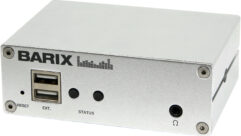Digital Signage and Emergency Notification
Jul 13, 2011 6:30 AM,
by Cynthia Wisehart
The term digital signage is so broad as to be almost meaningless; digital signage is much more than signage. Audio and video are becoming the de facto method of interactive, multi-purpose communication in institutions and public places a communication platform that can be used for marketing, training, tracking, or any combination of functions formerly handled by signs or by things that are not signs.
Maybe a digital signage system replaces another form of media a training DVD or a brochure, or a map. Maybe it’s used interactively as a form of public email.
In some cases, digital signage systems replace the services of something that was never a sign or piece of media at all, for example, the fire alarm bell.
This brings an interesting technical twist to digital signage. In some ways a digital signage network can be whatever you want it to be: a training platform, a marketing platform, wayfinding, scheduling, instant replay, remote collaboration anything you can envision within the limits of technology and your budget, designed however you wish, and optimized to standards of reliability and picture/sound quality that you define. But when one of the functions of a digital signage system is life safety, it becomes subject to the laws of equal access (ADA) and also a code of performance metrics defined and enforced by local and federal government agencies.
Last year, a significant development of this kind occurred when the National Fire Protection and Signaling Code NFSA 72 received a history-making rewrite. The code—which will go into force across the country on a locality by locality basis over approximately the next decade sets standards for AV systems that are used for mass notification and emergency communications. So the same digital signage system that carries retail advertising or background music in malls, wayfinding in hotels, or scheduling in airports, corporate, or educational communication may also need to carry mass notification and emergency communication. This will mean a material change to the way some digital signage systems are sold, designed, and installed. In this issue, we look at one of the most important technical considerations for digital signage systems that also serve as mass notification. That consideration is intelligibility a key factor of which is acoustics. It’s not something a fire alarm company will understand for obvious reasons.










